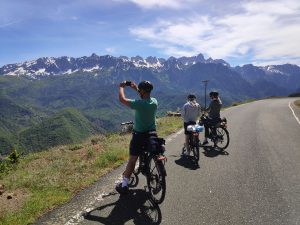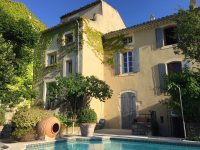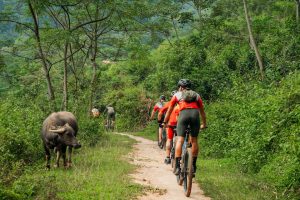On the 10th July 2017, the Lake District received World Heritage Site status, positioning it alongside destinations such as the Taj Mahal, the Tower of London and the Great Barrier Reef. Bravo and not unexpected.

There is so much to see and do, jump on a traditional steamboat chugging through tranquil lakes, or scale the highest mountains England has to offer and enjoy a jaw-dropping view. From the top of Scafell Pike, it’s easy to see how Cumbria’s lakes captivated William Wordsworth, Beatrix Potter and an endless list of creative and adventurous types.
Everybody has a bucket list, something they want to achieve before they die. Okay the lakes are not comparable to the Great Wall, the Grand Canyon or the pyramids but why has it taken me so long to venture to this mesmerising part of the UK. You have no need for TripAdvisor, this place has no flaws, with its expressive fells, obvious water, an abundance of tranquillity and plenty of cyclists, it’s simply a great arena to be, not just pedal!
Our base was in on the outskirts of the sleepy picture postcard village of Coniston. For me, luxury is barefoot immersion in nature, a crescendo of running waters, foraging amongst the leaves and bucolic pedalling. More and more people are craving the solitude of the wild, they don’t journey simply to escape, but to find, engage and connect. Fairsnape set in the hillside keeping eye on Coniston Water like a dedicated headteacher is the perfect solution.
The property is exceptionally Lakeland, managed by Coppermine’s Lakes Cottages and recently renovated, it offers travellers a magical glimpse of rural life juxtaposed by the clean lines of modernity. The tech savvy will be spoiled with underfloor heating, an array of stylish white goods and a massive wall mounted Smart television. The whole family are catered for, the owner has designed the house with either three generations of one family or three separate families in mind. In total the property can accommodate 12 guests in six stunning en-suite bedrooms.
Thankfully the owner Rob is a keen cyclist, clues dot the house. It’s no surprise his hope is to attract the rapidly evolving cycling crowd who are increasingly hungry for new and thought-provoking experiences. The target audience will encompass professionals with a reasonable income who actively seek adventure and want to tune into all the Lakes have to offer.
The house is ideally situated for the centre of Coniston and you can get the measure of village by strolling its 2 central characterful street, with local stores, gift shops, cafes and numerous pubs close by. Like all fascinating old villages crammed with treasures and beautiful old buildings, the village can attract too many people, and too many cars. Thankfully, popular valley and mountain walks and trails including gaining altitude on Old Man of Coniston & Tarn Hows can be accessed from the front door and the lake shore is less than a 15-minute stroll away.
I was up early the next morning after a sublime restful slumber. The weather was unexpected, bright blue skies and hypnotic chinks of sunlight, with only a hint of a cold early Spring wind. I headed in the direction of the Lake, the plan was to circumnavigate the 14 miles around Coniston water. I had hoped to trace a creative timeline. South of Torver there is a section of A road before turning up the hidden east side of the lake on very quiet roads when the ride passes Brantwood, home of John Ruskin.

Coniston Water is approximately 8km in length (making it the third longest in the National Park) and 804 metres at its widest and 55 metres at its deepest. I picked up a cycle track just on the outskirts of the village, the roads were quiet, however I can imagine it can sometimes feel a little too popular in the Summer months.
There is something mesmerising about the sound of water and nothing else. It’s hard to imagine the thunderous noise of a hydroplane speeding through the water and the historic legacy which has been etched on the lake’s persona, it has been the scene of many attempts to break the world water speed record. On 19 August 1939 Sir Malcolm Campbell set the record at 141.74 miles per hour (228.108 km/h or 123.168 kn) in Blue Bird K4. Between 1956 and 1959 Sir Malcolm’s son Donald Campbell set four successive records on the lake in Bluebird K7, a hydroplane. Unfortunately, in 1967 Donald lost control of Bluebird, which somersaulted and crashed, sinking rapidly and killing him instantly.
Most of the countryside in and around the lake is so seductive that it seems contrary to spend time in a car. East of the lake the road becomes most attractive, dominated by desolation. Due to my early start the surroundings were almost eerie, especially as I sat in silence on the shore watching the water enthusiastically lapping the banks. Bewildering, hypnotic, tranquil -superlatives rarely do justice to the spectacular landscapes of the Lake District. Craggy peaks, above verdant forests, alive with flowers.
Several miles along the eastern shore and I stumbled on a lovely property once owned by local lad John Ruskin. In the Lakes he is admired not only for his writing but for his paintings and drawings. This historical Lakeland estate comprises 250 acres, with remarkable gardens created by John Ruskin, his cousin Joan Severn and head gardener Sally Beamish. Beautiful in all seasons with spectacular views across Coniston water to the fells.

Ruskin’s former home has a wealth of things to see and do for the whole family. Brantwood offers a fascinating insight into the world of John Ruskin and the last 28 years of his life spent in the Lakes. Filled with many fine paintings, beautiful furniture and Ruskin’s personal treasures, the house retains the character of its famous resident.
Further along the trail and you will encounter another famous author, Arthur Ransome. The magic of Coniston enraptured Ransome from the cradle to the grave, so it is hardly surprising that the surroundings provided his muse for his fictional ‘great lake in the north’, where the Swallows and Amazons adventured, should be so deeply rooted in the area.
Star attraction is Peel Island and its secret harbour which he borrowed for Wild Cat Island. Ransome had spent many childhood holidays on Coniston Water, and explained later that the book had almost written itself out of his memories. “We adored the place,” wrote the author, who was born in Leeds. ‘“Going away from it, we were half drowned in tears.”
Thanks in part to Ransome’s stories, generations of visitors to Lakeland have shared this sentiment. Who wouldn’t be attracted to the childlike glee and exuberance of discovery and adventure? Once again, I was mesmerised by the silence, it was simply hypnotic, provoking an innocent trance. Epicureans will be spoilt with the array of rocky escarpments shadowing off-the-beaten-paths, that will round out the sense of enchantment.
Coniston Boating Centre is great place to grab a coffee, the Bluebird Café provides sustenance with stunning views. Explore the lake by boat and feel the wind in your hair. They have a selection of sailing vessels from motor boats (including an accessible motor boat), rowing boats, sit on top kayaks and open top Canadian canoes, paddle boards and sailing dinghies. If you prefer your feet firmly on dry land, they hire bikes too, whizz through the fantastic scenery by mountain bike as you explore a selection of different routes on offer.
If you’d like to explore further, you could head to the nearby Grizedale Forest where you will find miles of way-marked cycling and walking trails. You could also follow the Cumbria Way a couple of miles to the north east where you will find the beautiful Tarn Hows and the pretty Monk Coniston estate.
The Lakes have something to offer every cycle tourist. Whether you’re looking for a leisurely family holiday, an indulgent spa immersion or a dip into a cultural and historical hot bed, you’ll find it here. A self-propelled visit will free you from the pace of an over packed bus tour program.
For more information see Cumbria Tourism
Getting there?
By air
The nearest airports are Manchester to the south and Glasgow to the north. There is a railway station at Manchester airport with services that run to Oxenholme next to Kendal, Kendal, Staveley and Windermere.
From Spring 2019 Carlisle Lake District Airport will be open offering flights from Dublin, Belfast and London Southend.
By car
The average journey time from London and the south east is about five hours. It takes about one and half hours from Manchester and two hours from York.
The M6 runs to the east of the Lake District National Park:
Take Junction 36 and then A590 for the southern end of the Lake District
Take Junction 40 and the A66 or A592 for the northern end of the Lake District
Even A roads can be quite twisting so allow extra time for your journey and for finding a space in Car parks in high season. Example journey times are:
Kendal to Keswick: one hour
Windermere to Keswick: 40 minutes
Kendal to Wasdale: one and a half hours
Hardknott Pass and Wrynose Pass between Eskdale and the Langdales have gradients of 1 in 3 and Honister Pass between Borrowdale and Buttermere is 1 in 4, making them some of the steepest roads in England!
By Bike
Several cycle routes link into the National Park from further afield including the famous C2C and the recently opened Lakes and Dales Loop. There are also local routes heading into the National Park from surrounding towns such as Kendal and Penrith.
Trains
The West Coast mainline runs to the east of the Lake District, connecting Oxenholme, Penrith and Carlisle with London and Glasgow. A direct train runs from Manchester to Windermere. Local trains call at Kendal, Staveley and Windermere. There is also a scenic route following the Cumbrian coastline with stops at Grange-over-sands, Ulverston and Foxfield which give access to the Lake District, and has stations at Silecroft and Bootle for climbing Black Combe and Ravenglass for walks into Eskdale and the Ravenglass and Eskdale Railway.
Twitter: cadencemag
Website: cadencemag.co.uk
Author, ‘Simple Words from the Saddle, Simply More Words from the Saddle & The Way of St James’
Twitter: @saddlescot







































